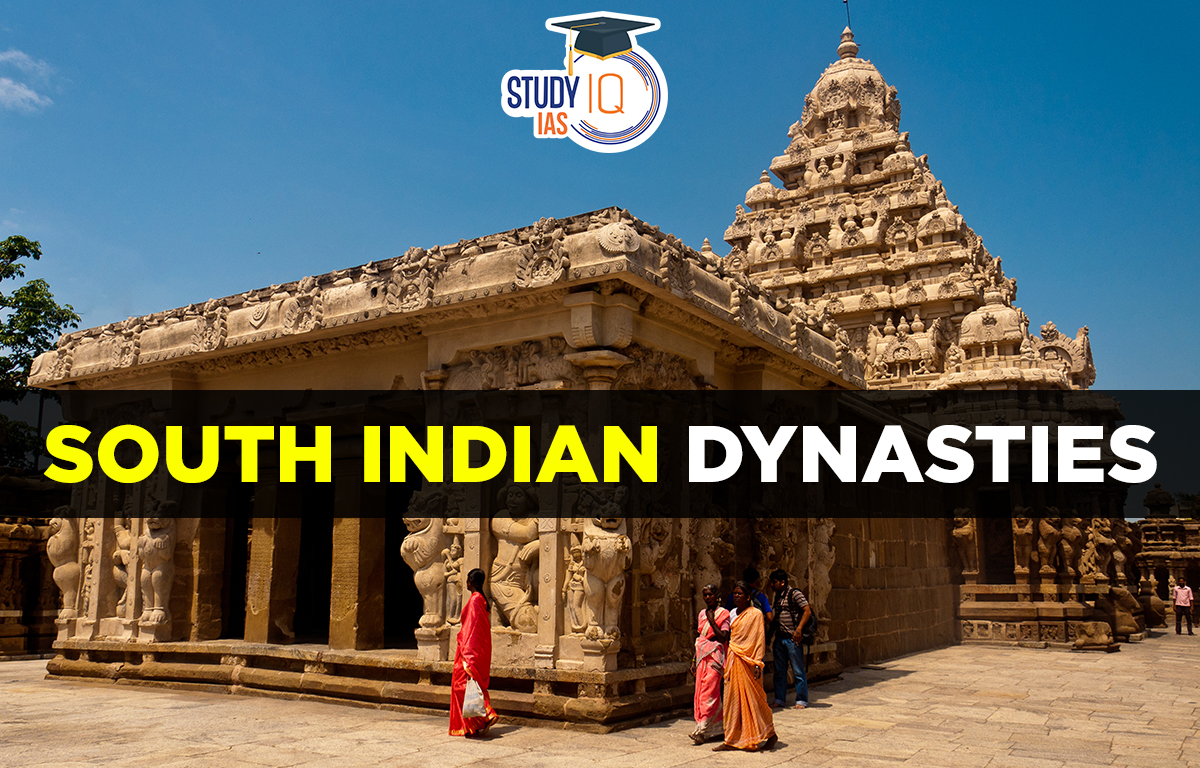Table of Contents
South Indian Dynasties
The term “South India Dynasties” refers to the various dynasties and kingdoms that dominated the southern part of the Indian subcontinent, mainly the area south of the Vindhyas, although some of them also expanded into the northern portion. You can better prepare for the Ancient History section of the UPSC Syllabus by reading this article, which will describe the South Indian Dynasties during the ancient era.
Read about: Sangam Period
South Indian Kingdom History
The history of South India spans more than 4000 years, with many dynasties rising and collapsing. South India’s ancient history is known as the Sangam Age, which spanned from the sixth century BC to the third century CE. South India’s ancient past has few inscriptions and records. We only have genuine archaeological proof from the early Common Era, despite the fact that there is evidence that dates back several centuries BCE.
Writing from the northern neighbours of the Vindhyas did not reference the south until around 600 BC. The southern region was ruled by the three Tamil kingdoms Chola, Chera, and Pandya from 268 to 232 BCE. Their history, which extends from antiquity to the eighteenth century, had a significant impact on the region’s socio-cultural elements.
| Name of the Kingdom | Capital of the Kingdom | Emblem | Premium Port of the Kingdom |
|
Pandyas Dynasty: It covers Tirunelveli, Madurai, Ramnad districts and south Travancore. |
Madurai | Fish | Korkai |
| Cholas Dynasty: It covers the Tanjore and Tiruchirappalli districts of Tamil Nadu. | Uraiyur | Tiger | Puhar (modern Kaveripattanam) |
| Cheras Dynasty: It covers mostly the Kerala coast. | Vanji / Karuvur | Bow | Tondi and Muchiri |
Read about: Rig Vedic Period
Major South Indian Dynasties
1. Chola Dynasty
The Cholas were one of the three main dynasties that governed south India since antiquity. Karikala Chola (late 2nd century CE) was the most famous king during the dynasty’s early years, acquiring control over the Pandyas and Cheras. On the other side, the Chola dynasty started to fall apart around the fourth century CE.
The Kalabhras, who descended from northern Tamil land during this time, ousted the established kingdoms and ruled the majority of south India for nearly 300 years. After defeating Ilango Mutharaiyar in 850 CE, Vijayalaya Chola revived the Chola Empire by capturing Thanjavur and making it his capital. His son Aditya I vanquished Pallava monarch Aparajita, extending Chola dominion to Tondaimandalam. The main cities of the Chola Kingdom were Thanjavur and Kanchi (Kanchipuram).
Raja Raja Chola was one of the most powerful kings of the Chola Empire, ruling from 985 to 1014 CE. His troops seized Anuradhapura and the northern province of Ceylon after defeating Thiruvananthapuram’s Navy of the Cheras. Rajendra Chola I began a massive naval campaign that took control of parts of Malaya, Burma, and Sumatra in addition to annexing Bengal and conquering Sri Lanka. The Chola armada represented the height of ancient Indian maritime might.
The Pandya resurgence caused the Chola Empire to start declining in the 13th century, and it finally came to an end in 1279. The early Dravidian temple architecture left by the Cholas, who were expert builders, is among the most beautiful in existence. A good illustration is the Brihadisvara Temple in Thanjavur, which is a United Nations World Heritage site.
Below given is the complete list of Chola Dynasty Rulers of the South Indian Dynasty:
| Rulers | Reign |
| Vijayalaya Chola | 848-871 AD |
| Aditya I | 871-907 AD |
| Parantaka Chola I | 907-950 AD |
| Gandaraditya Chola | 950-956 AD |
| Arinjaya Chola | 956-957 AD |
| Sundara Chola | 957-970 AD |
| Uttama Chola | 970-985 AD |
| Rajaraja Chola I | 985-1014 AD |
| Rajendra Chola I | 1012-1044 AD |
| Rajadhiraja Chola | 1044-1054 AD |
| Rajendra Chola II | 1054-1063 AD |
| Virarajendra Chola | 1063-1070 AD |
| Athirajendra Chola | 1070-1070 AD |
| Kulothunga Chola I | 1070-1122 AD |
| Vikrama Chola | 1118-1135 AD |
| Kulothunga Chola II | 1133-1150 AD |
| Rajaraja Chola II | 1146-1173 AD |
| Rajadhiraja Chola II | 1166-1178 AD |
| Kulothunga Chola III | 1178-1218 AD |
| Rajaraja Chola III | 1216-1256 AD |
| Rajendra Chola III | 1246-1279 AD |
2. Chera Dynasty
From ancient times until the 12th century CE, southern India was governed by the Tamil dynasty known as the Chera kingdom. The Early Cheras governed over the present-day Indian states of Kerala and Tamil Nadu, as well as the Malabar Coast, Coimbatore, Erode, Namakkal, and Salem Districts in South India.
Throughout the Early Cheras’ reign, trade continued to bring wealth to their lands, exporting spices, ivory, wood, pearls, and gems to the Middle East and southern Europe. The Malabar Coast (Muziris), Karur, and Coimbatore districts have abundant historical evidence of extensive foreign commerce.
Below given is the complete List of Rulers of Early Cheras and Later Cheras of the South Indian Dynasty:
| Early Cheras | Period |
| Uthiyan Cheralathan | N/A |
| Nedum Cheralathan | N/A |
| Selva Kadumko Valiathan | N/A |
| Senguttuvan Chera | N/A |
| Illam Cheral Irumporai | N/A |
| Mantaran Cheral | N/A |
| Later Cheras | Timeline (CE) |
| Kulashekhara Varma | 800-820 |
| Rajashekhara Varma | 820-844 |
| Sthanu Ravi Varma | 844-885 |
| Rama Varma Kulashekhara | 885-917 |
| Goda Ravi Varma | 917-944 |
| Indu Kotha Varma | 944-962 |
| Bhaskara Ravi Varma I | 962-1019 |
| Bhaskara Ravi Varma II | 1019-1021 |
| Vira Kerala | 1021-1028 |
| Rajasimha | 1028-1043 |
| Bhaskara Ravi Varma III | 1043-1082 |
| Ravi Rama Varma | 1082-1090 |
| Rama Varma Kulashekhara | 1090-1102 |
3. Pandya Dynasty
Along with the Chola and Chera kingdoms, the Pandyan dynasty was one of the three historic Tamil dynasties. The Three Crowned Kings of Tamilakam were the titles given to the rulers of the three kingdoms. Over what is now southern Tamil Nadu, the Pandyas held sway. Their main city was Madurai. They governed from the beginning of time until the end of the 15th century.
Pandyas are mentioned in Sangam Literature. The early Pandyan kingdom of Sangam literature vanished into obscurity during the Kalabhra invasion. Kadungon, who expelled the Kalabhras from Tamilian territory and governed from Madurai, brought the dynasty back to life at the beginning of the sixth century. They went backwards in development after the Cholas rose to power in the ninth century, and they were at continuous odds with them.
The Pallavas, Cholas, Hoysalas, and ultimately Muslim invaders from the Delhi Sultanate were in conflict with the Pandyas. Following the establishment of the Madurai Sultanate in the fourteenth century, the Pandyan Dynasty was wiped out. The Pandyas achieved greatness in both commerce and literature. They were in charge of the South Indian coast’s pearl fisheries, which created some of the finest pearls ever seen in antiquity between Sri Lanka and India. Originally Jains, the Pandyas subsequently converted to Shaivism. They are referenced in Megasthenes’ accounts and had close ties to Egypt, Rome, and China.
Below given is the complete List of Rulers of the Pandya Dynasty of South Indian Dynasties:
| Rulers | Reign (AD) |
| Nedunjeliyan I | 180 |
| Nedunjeliyan II | 210 |
| Kadungon | 590-620 |
| Maravarman Avani Sulamani | 620-640 |
| Jayantavarman | 640-670 |
| Arikesari Maravarman | 670-710 |
| Kochadaiyan Ranadhiran | 710-735 |
| Srimara Srivallabha | 815-862 |
| Varagunavarman II | 862-880 |
| Maravarman Rajasimha III | 900-920 |
| Maravarman Sundara I | 1216-1238 |
| Maravarman Kulasekara I | 1268-1310 |
Read about: Later Vedic Period
Other Important South Indian Dynasties
1. Pallava Dynasty
Between the third and ninth centuries CE, the Pallavas, a powerful south Indian dynasty, governed. Their centre was Kanchipuram, located in Tamil Nadu. Their beginnings are still a mystery. They were yadavas and most likely Satavahana feudators, it is believed, though. Pallava rule was established in the valley of the Krishna River, now known as Palnadu, and it later expanded to southern Andhra Pradesh and northern Tamil Nadu.
An important Pallava monarch named Mahendravarman I started construction on the Mahabalipuram rock-cut temples. His descendant Narasimhavarman I took the throne in 630 CE. He overthrew the Chalukya monarch Pulakeshin II in 632 CE and set fire to Vatapi, the Chalukyan capital. The southern regions were controlled by the Pallavas and Pandyas between the sixth and ninth centuries CE.
2. Kadamba Dynasty
One of South India’s most potent kingdoms was the Kadambas. From 345 to 525 CE, the Kadambas governed. The area that is now known as Karnataka was part of their empire. Banavasi served as their headquarters. They widened their domain to encompass Goa and Hanagal. Around 345 CE, Mayura Sharma founded the empire. They built stunning shrines in Goa, Halsi, Belgaum, and Banavasi.
The first kings to use Kannada as an official language were the Kadambas, as evidenced by the Halmidi inscription (450 CE) and the Banavasi copper coin. The Kadambas continued to govern as their feudatory from 525 CE until the rise of the Badami Chalukya dynasty.
3. Gangas Dynasty
The Western Ganga Dynasty reigned over southern Karnataka from 350 to 550 CE. They governed as Chalukya and Rashtrakuta feudatories until the tenth century. They emerged from the area following the fall of the Satavahana Empire and founded a kingdom in Gangavadi (south Karnataka), while their contemporaries, the Kadambas, did the same in north Karnataka.
The modern-day districts of Mysore, Chamarajanagar, Tumkur, Kolar, Mandya, and Bangalore were all part of Gangavadi, which they governed over. They governed as Chalukya and Rashtrakuta feudatories until the tenth century. The Gangas built Kolar as their capital before moving it to Talakad, close to Mysore. They contributed significantly to Kannada writing, with authors like King Durvinita, King Shivamara II, and Chavundaraya among their ranks. In Shravanabelagola, they built the well-known Jain temples.
4. Chalukya Dynasty
From 543 to 757 CE, the Chalukya Empire controlled a region that spanned the Kaveri and Narmada waterways. One of the first rulers of the Chalukyan Empire was Pulakeshin I. He reigned over Karnataka from Badami, which is now Bagalkot. His son Pulakeshin II ascended to the throne in 610 CE and ruled the Chalukyan kingdom until 642 CE. Pulakeshin II is best remembered for his battle with Emperor Harshavardhana in 637 CE and eventual victory. He also triumphed over Pallava King Mahendravarman I.
The Chalukyas developed the Chalukyan architecture style. Pattadakal, Aihole, and Badami all have magnificent monuments. These temples represent the evolution of the Vesara architectural style. The Chalukyas of Vengi, also known as the Eastern Chalukyas and related to the Badami Chalukyas, ruled along South India’s east coast around present-day Vijayawada. Kubja Vishnuvardhana, Pulakeshin II’s brother, founded the Eastern Chalukya dynasty.
5. Rashtrakuta Dynasty
The Rashtrakuta Dynasty ruled from Manyaketha in Gulbarga from 735 to 982 CE, achieving its pinnacle under Amoghavarsha I (814–878 CE), who is known as the Ashoka of South India. The Rashtrakutas came to power after the Badami Chalukyas fell from power and were engaged in a three-way power struggle for control of the Gangetic plains with the Prathihara of Gujarat and the Palas of Bengal.
Some of Ellora’s most exquisite rock-cut shrines, such as the Kailasa temple, were built by the Rashtrakutas. Kannada literature thrived under the rule of Adikavi Pampa, Sri Ponna, and Shivakotiacharya. King Amoghavarsha I penned Kavirajamarga, the first surviving Kannada masterpiece.
6. Hoysala Dynasty
The Hoysalas were initially Chalukyas of Kalyani’s servants before eventually forming their own empire. Nripa Kama Hoysala, who ruled over the western Gangavadi area, is credited with founding the Hoysala dynasty. His later successor, Ballala I, governed from his centre of power in Belur. Vishnuvardhana Hoysala (1106–1152 CE) earned the moniker Nolambavadi Gonda for his conquest of the Nolamba region.
7. Kakatiya Dynasty
The Kakatiya dynasty gained power in the 11th century with the fall of the Chalukyas. By the end of the century, their empire had expanded between the Godavari and Krishna rivers, reaching the Bay of Bengal. The greatest emperor of the kingdom, Ganapatideva, guided it to its zenith. The kingdom at its height included most of present-day Andhra Pradesh, along with portions of Odisha, Maharashtra, Chhattisgarh, and Karnataka. Ganapatideva’s daughter Rudramamba replaced him. Japan was governed by the Kakatiya dynasty for three centuries. Its main city was Warangal.
Read about: Sangam Literature
South Indian Kingdom UPSC
The history of South India covers more than 4000 years, during which time numerous dynasties rose and fell. South India’s ancient history is referred to as the Sangam Age, which spanned from the sixth century BC to the third century CE. The various dynasties and kingdoms that controlled the southern part of the Indian subcontinent, mainly the area south of the Vindhyas, are referred to as “South Indian Dynasties,” though some of them also acquired territory in the northern part during their rule. Candidates can go to the official website of StudyIQ UPSC Online Coaching for more to Learn about UPSC Examination.
Read about: Gupta Empire


 Birsa Munda Birth Anniversary 2025: Life...
Birsa Munda Birth Anniversary 2025: Life...
 Military Innovations of Afghans and Turk...
Military Innovations of Afghans and Turk...
 Self-Respect Movement, History, Objectiv...
Self-Respect Movement, History, Objectiv...

























